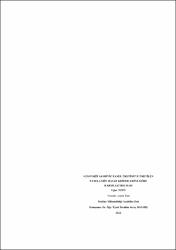| dc.contributor.author | Özen, Uğur | |
| dc.date.accessioned | 2018-08-01T07:25:55Z | |
| dc.date.available | 2018-08-01T07:25:55Z | |
| dc.date.issued | 2018 | |
| dc.identifier.uri | https://hdl.handle.net/20.500.11776/2929 | |
| dc.description.abstract | Bu çalışmada, sandviç kompozit panellerin eğilme ve basma rijitliğini arttırmak amacıyla farklı çekirdek yapılı kompozit paneller incelenmiştir. Piramit, Konik, Federli-Konik olmak üzere üç tip çekirdek yapısı incelenmiştir. Bu panel yapıları yumurta kutu yapımından esinlenerek tasarlanmıştır. Kompozit paneller vakum infüzyon yöntemi kullanılarak üretilmiştir. Çekirdek ve plaka üretiminde cam elyaf kumaş ve epoksi reçine ve bunları birbirine yapıştırmak için epoksi bazlı yapıştırıcı kullanılmıştır. Üretilen kompozit plakaların eğilme dirençleri birbirlerine çok yakın olmakla birlikte piramit çekirdekli panelin eğilme direnci diğerlerine göre daha yüksek çıkmıştır. Basma testinde ise federli-konik çekirdek yapılı kompozit panelin basma rijitliği ve dayanımı diğer panellere oranla yaklaşık iki kat daha fazladır. Sonlu elemanlar yöntemi kullanılarak üç nokta eğme testi modellenmiştir. Modelde Tsaih hasar kriteri kullanılarak hasar bölgeleri belirlenmiş ve test sonuçları ile karşılaştırılmıştır. Sonuçlar incelendiğinde, model hasar bölgelerini yeterli yakınlıkta bulmuştur. | en_US |
| dc.description.abstract | In this study, composite panels with different core structures were investigated to increase the bending and compression stiffness of the panels. Three type of core structures were examined. These were pyramid, conical, and supported-conical. These panels were designed with inspiration from the egg box. Composite panels were produced using vacuum infusion method. Glass fiber fabric and epoxy resin were used to the manufacture cores and the face sheets, and epoxy-based adhesive was used to adhere the core and the facesheets. The bending resistance of the composite panels with different cores was very close to each other, but the bending resistance of the pyramidal core panel was higher than the others. In the compression test, the compressive strength and rigidity of the composite panel with supported conical core structure was about twice that of the other panels. The three-point bend test was modeled using the finite element method. Damage zones were determined using the Tsaih damage criterion in the model and compared with the test results. When the results were examined, the model found the damage areas close enough. | en_US |
| dc.language.iso | tur | en_US |
| dc.rights | info:eu-repo/semantics/openAccess | en_US |
| dc.subject | Kompozit panel | en_US |
| dc.subject | Yumurta kutusu | en_US |
| dc.subject | Sandviç yapılar | en_US |
| dc.subject | Vakum infüzyon yöntemi | en_US |
| dc.subject | Composite panel | en_US |
| dc.subject | Egg box | en_US |
| dc.subject | Sandwich structures | en_US |
| dc.subject | Vacuum infusion method | en_US |
| dc.title | Kompozit sandivic panel üretimi ve üretilen panellerin hasar kriterlerine göre karşılaştırılması | en_US |
| dc.title.alternative | MANUFACTURING OF COMPOSITE SANDWICH PANEL, AND COMPARISON OF THE PANELS MANUFACTURED ACCORDING TO FAILURE CRITERIA. | en_US |
| dc.type | masterThesis | en_US |
| dc.department | Enstitüler, Fen Bilimleri Enstitüsü, Makine Mühendisliği Ana Bilim Dalı | en_US |
| dc.relation.publicationcategory | Tez | en_US |



















